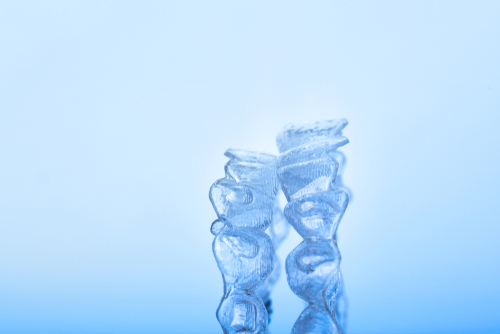
If you’ve ever gotten a close look at an Invisalign tray, you probably noticed the miniature shapes within. These are the areas where attachments fit snugly into the aligner. Attachments themselves are bonded on the teeth temporarily to help guide the movement of teeth throughout treatment. Though they are small, attachments are mighty, and it’s good to know how they work and what your responsibility is when caring for them.
Getting Specific About Attachments
Invisalign attachments come in multiple shapes. Each is quite intentional and placed in precise spots on the teeth. Though the bumps stick out a little and can be noticeable when your trays are out of your mouth, they are made of composite resin or dental bonding, so the bumps blend into tooth enamel.
Attachments – also referred to as SmartForce – can be round, square, rectangular, triangular, angular half-moons, and more. The goal is to make sure the right shape is positioned in the right place to help the trays move teeth effectively. Here are some of the most common names for Invisalign attachments that you may hear your orthodontist use during treatment:
- Button attachment. Round and small, this is the most common type.
- Rectangular attachment. A super strong way to control tooth movement.
- Canine attachment. Designed to fit on the cuspids to help rotate them.
- Incisal edge attachment. Aligns the front teeth.
- Power ridge attachment. A ridge-like attachment that offers greater leverage for movement.
The Technology Behind Invisalign Attachments
Invisalign is a force-driven treatment system and attachments help make it work well. Whether you refer to them as anchors or buttons, attachments hold a lot of power and move tooth roots and crowns effectively when trays are worn as instructed. SmartForce technology is designed so attachments work like handles and give clear trays something to push with a little extra force to realign teeth.
- It can feel a little strange at first to have attachments on your teeth.
- The buttons could be straight or crooked, up high or low on a tooth.
- Attachments are deliberately shaped to suit your tooth movement needs.
- You will experience some mild discomfort initially as teeth adjust to the new pressure.
- Attachments minimize unwanted movements when aligning teeth.
Attachments for Invisalign and Invisalign Teen
Attachments might seem annoying to many people, but this feature is one of the reasons Invisalign and Invisalign Teen are so efficient. Straightforward orthodontic treatment time can be reduced thanks to these temporary little dots that help teeth move. It’s important to take care of Invisalign attachments so they stay in place as long as they’re needed and can be most effective.
- Avoid eating sticky, chewy foods so you don’t destroy buttons.
- Do not use your teeth as a tool because it could loosen attachments.
- Brush attachments every day to keep them clean, strong, and subtle.
- Remove and insert aligners safely as instructed.
Is Invisalign Right for You?
Not every Invisalign patient needs attachments but many do. Schedule a consultation with Dr. Soleil and her team at Soleil Orthodontics in Woodinville, WA, to find out if you’re a good candidate for Invisalign and all its facets.

